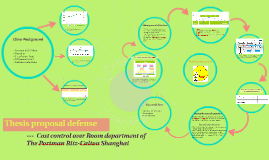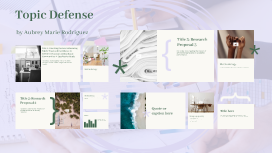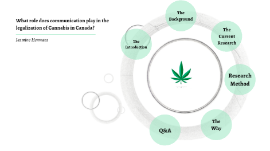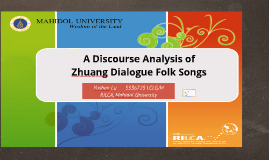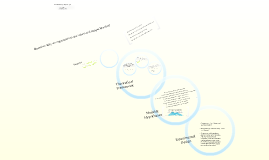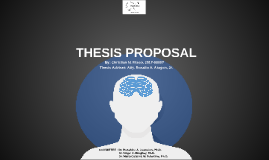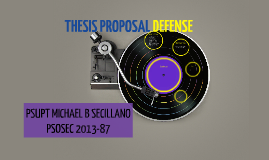Thesis proposal defense
Transcript: This study will draw data from the collected work of Liao Songs. Above turn-pairs level: Sequence and Joint A pre-survey of text distribution in 3 major Zhuang media sources: newspapers, magazines, textbooks Step 1: to divide the text into units; Step 2: to identify text spans and relations. Methodology Translation: Peng,2013; Zhang 2013; Zhou 2012 Semantic metaphor: Lu, 2013; Zhou, 2011a & 2011b Writing system: Wei,2010 The sample text sp4: nucleus Speech functions in male turns sp1:nucleus N-N relations: 1) Another language of communication of Zhuang people. (Qin, 2005) (based on the statistics of WANFANG DATA) 1. How are the texts of Zhuang dialogue folk songs organized? Data selection 5. Liao Songs of Pingguo Zhuang (Luo & Tan, 2008) Two criteria for text selection Luo and Tan's (2008) work consists of 5 volumes, each volume is concerned with a particular social theme. Each volume consists of different number of chapters, and each chapter consists of different number of lines. To scope and valid the data, purposely select one chapter from each volume for analysis. 1. Content-based criterion: the content of each selected chapter must be related to the social theme of the volume which selected from as much as possible. Yunnan Analyzing tools Linguistic studies, especially discourse studies, on Zhuang folk songs are still limited. Cultural value of Zhuang folk songs Mechanisms of RST sp3: nucleus 3. The ancient collection of Zhuang folk songs: Liao Songs (Huang, 1993) Guangxi Liao Songs is a Zhuang dialogue folk songs collection, which was created since Qin Dynasty (221-206 AD), and widely spread among the Zhuang speaker communities. Thus, it is considered as the representative work of Zhuang folk songs. (Liang, 2008; Qin, 2005) Research questions (Mann & Thompson, 1988; Mann et al, 1992) Hunan Outline of the presentation Yushan Lu 5536725 LCLG/M RILCA, Mahidol University Data collection Data analysis 1 Applies and examines both of Rhetorical Structure Theory and Speech Function model to a minority language (i.e. Zhuang) and a text type that has not been explored (i.e. dialogue folk songs). Stage 2: Functional analysis (Speech function analysis) 2. To interpret the interaction between singers in Zhuang dialogue folk songs. Evidence Justify Antithesis Concession Circumstance Solutionhood Elaboration Background Enablement Motivation Purpose Condition Otherwise Interpretation Evaluation Restatement Summary Volitional cause/result Non-volitional cause/result 2. How do the singers interact each other in Zhuang dialogue folk songs ? 2 In turn-pairs level: Addition, Restatement, Solutionhood Data preparation A Discourse Analysis of Zhuang Dialogue Folk Songs 2. For Zhuang linguistic studies: 1) How a singer or a group of singers initiate a singing turn? 2) How the other singer or the other group of singers respond to the former singer(s)? Approaches on discourse structure 6 (nucleus & satellite, nucleus & nucleus ) 1) the largest minority ethnic group in China; 2) numbering over 16 million people; 3) most reside in southern China. Stage 1: Structural analysis (RST analysis) Step 1: to divide the text into moves; Step 2: to identify speech function of each move. Widely distribution of Zhuang folk songs Rhetorical Structure Theory (RST) 7 sp2: satellite May be an inspiration for more discourse studies on Zhuang in the future. Eggins & Slade's (1997) speech function model Guangdong 3) An Intangible Cultural Heritage in China. (The State Council of China, 2008) An up-trend of the studies on Zhuang folk songs The Zhuang folk songs festival Halliday's speech function model 1. Background & Rationale 2. Objectives & Questions 3. Expected benefits 4. Previous studies 5. Research framework 6. Research design: Methodology Relations found in the analysis of sample text 5 Expected benefits Research objectives An example of data analysis 3 2. The intra-turn structure To explore two major discourse features of Zhuang dialogue folk songs: UAM Corpus Tool (v. 2.8.12) (for speech function analysis) Results: -Total 240 texts are collected from the 3 major Zhuang media sources; -Different media favor different text types; -Folk songs is the only text type that shared by all the 3 media. 1. For Zhuang folk songs studies: A singing turn always consists of 4 lines; The 1st -2nd lines provide the background information for the 3rd- 4th lines. The 3rd-4th lines consist of the main contents of the singing turn. 1) Refer to the songs and ballas sung by Zhuang people in Zhuang language, the history of which can be traced back to the worship ceremonies in Zhuang primitive society thousands of years ago. 2) Most of Zhuang folk songs are created in dialogic mode. (Feng, 2007; Qian, 2008) (source: WANFANG DATA) Analysis: Structural analysis (RST) Functional analysis (Speech function model) May help the readers or listeners of Zhuang dialogue folk songs to better understand the songs at discourse level. Relations: relationships between text






